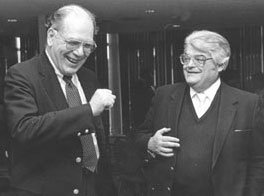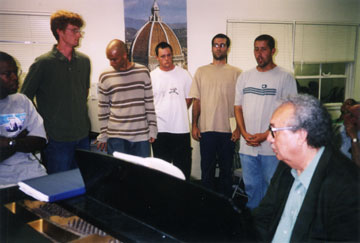A Revolution in Musical Tuning
Return to Verdi’s Scientific Pitch
C=256 Hertz
Motivführung in Beethoven (5 videos with Norbert Brainin) (a.k.a. Violinist Norbert Brainin Demonstrates the Principle Of Motivic Thorough Composition, Slovakia, Summer 1995)
Revive Verdi's tuning to bring back great music (EIR, PDF format, August, 1988)
|
Beethoven's Ninth Symphony Berlin, Germany, March 25, 2010
|
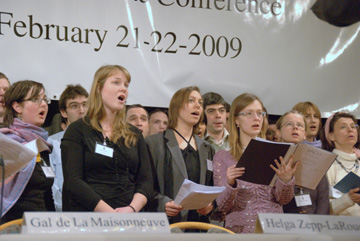 Bach’s Jesu Meine Freude by the LaRouche Youth Movment Chorus at the Schiller Institute Conerence in Rüsselsheim, Germany, February, 2009. |
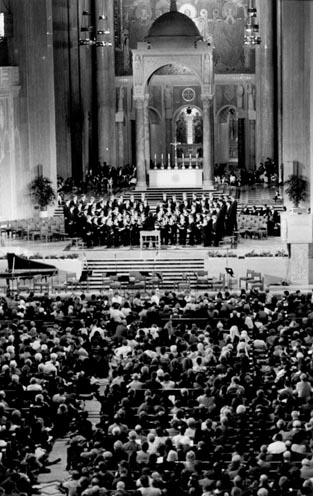 Thousands Crowd into DC Church to Hear The Leipzig St. Thomas Boys Choir, 1998 |
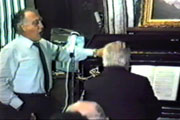 Baritone Piero Capucilli at Casa Verdi, demonstrating superiority of Verdi tuning, 1988 Schiller Institute Conference |
“Musical Art”
Life is breath’d by the formative art, bards I ask for spirit,
Yet the soul doth give but Polyhymnia voice.
(epigram by Friedrich Schiller)
List of All Music Articles and Links,
including:
Fidelio Online: Music Articles and Interviews
Fidelio Online: Reviews of Art and Music Performances
Return to the SCIENTIFIC TUNING! (below)
Historic Performances at C=256hz Video
Denmark Schiller Institute Pedagogy Page
Chart of Vocal Registers (6 Species of the Singing Voice)
The National Conservatory of Music Movement
Save the African-American Spiritual
Concert Programs with texts, and articles about Schiller music workshops, conferences, and events.
Schiller Institute Concerts Page
Order Verdi Pitch Tuning forks
A = 432 Hz
C = 256 Hz
C = 512 Hz
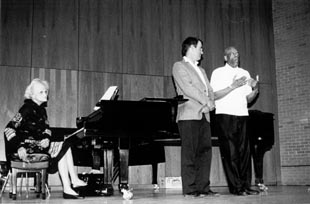 Houston Workshop |
Science and Music:
Without Both, You Have Neither!
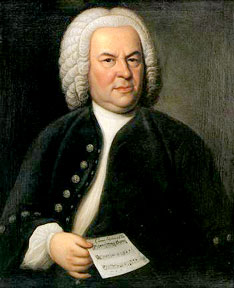 Johann Sebastian Bach, 1685-1750 |
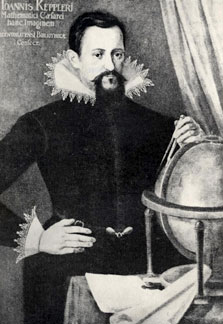 Johannes Kepler 1571-1630 |
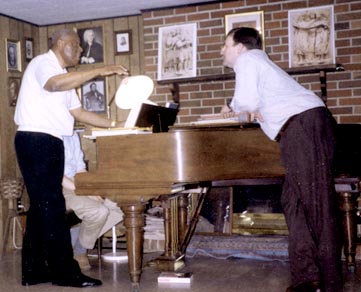 William Warfield and John Sigerson work through the Dichterliebe, circa 1995, at one of the many informal Coaching Sessions with the Schiller Institute singers and chorus members |
 LaRouche Youth Movement Brings Bel Canto Singing to the Streets, 2007 |
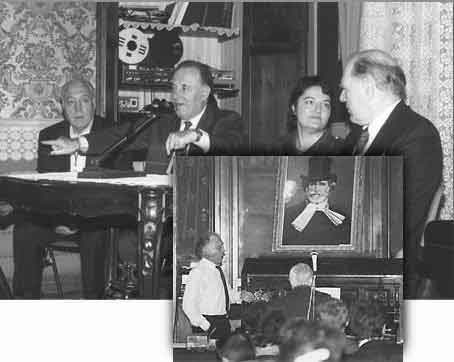 |
From left to right: Piero Cappuccilli, Carlo Bergonzi, Liliana Gorini and Lyndon LaRouche in,November 1997, at the Salone Barezzi di Busseto, at the conference presenting book "Canto e Diapason", the Italian edition of the Schiller Institute’s “Manual on Tuning and Registration.” Piero Cappuccilli demonstrated “Oh dei verd’anni miei” at the Verdi pitch (La=432 Hz) during the first conference on the scientific tuning at the Casa Verdi in Milan in November 1988. |
|
In Memoriam: Great Musician, Poet, |

|
The Campaign to Lower The Pitch
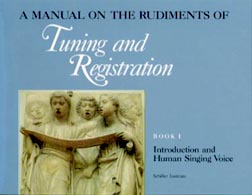 The Schiller Institute's “Manual on the Rudiments of Tuning and Registration”, Volume I, is now AVAILABLE ON CD-Rom for $50. The Schiller Institute's “Manual on the Rudiments of Tuning and Registration”, Volume I, is now AVAILABLE ON CD-Rom for $50.
CALL703-297-8368 |
The Milan conference also heard presentations, among others, from Prof. Bruno Barosi of the Cremona International Institute of Violinmaking, Dr. Jonathan Tennenbaum of the Fusion Energy Foundation on the astrophysical basis of the C = 256 tuning, and soprano Renata Tebaldi on the absolute necessity to reverse the tendency toward raising the pitch in performance, in order to save the voices of today's and tomorrow's singers. World-famous Verdi baritone Piero Cappuccilli demonstrated the difference between the Verdi tuning and today's higher pitch by singing two Verdi arias in the two tunings.
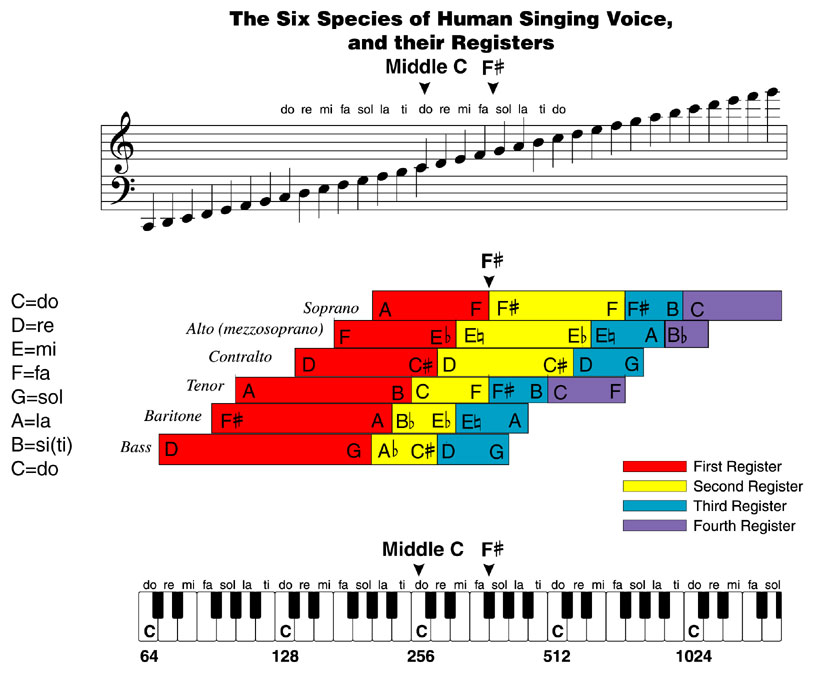
In the months following the conference, the movement to return to “Verdi's A” had gained momentum, and in July, in Rome, Senators of the Republic Boggio and Mezzapesa introduced a law into the Italian Senate to make A=432 the mandatory pitch for all state-subsidized performances and teaching institutions. Although it did not become law at that time, the momentum for this idea continues to grow, as the 100th birthday of Verdi's death in 2001 is celebrated.
The fact that the level of pitch is no mere professional detail, was underlined by the star-studded list of endorsers of the conference's aims. That list included: Spanish soprano Montserrat Caballe, Swiss soprano Anneliese Rothenberger, Spanish tenor Alfredo Kraus, German bass Kurt Moll, Mexican-Spanish tenor Placido Domingo, German soprano Edda Moser, Italian baritone Piero Cappuccilli, Italian tenors Luciano Pavarotti, Carlo Bergonzi, and Giuseppe Di Stefano, and hundreds of others. The Institute's work in this regard has continued to radiate internationally since 1988, affecting virtually every major musical institution and performer worldwide.
To maintain the offensive, the Schiller Institute regularly sponsors concerts and musical demonstrations at the lower pitch, featuring such major performers as Norbert Brainin, former lead violinist of the Amadeus Quartet, and Italian tenor Carlo Bergonzi. Beginning in May 1994, the Schiller Institute launched a movement for a new National Conservatory of Music, in honor of the great African-American artist Marian Anderson, who had passed away a year earlier.
top of page
Why You Should Join the
National Conservatory of Music Movement
The first National Conservatory of Music, which is the inspiration for this movement, was conceived one hundred years ago, as an attempt to institutionalize in the United States a program of Classical music performance and composition. Its founder, Jeanette Thurber, not only brought the great musician Antonin Dvorak to the United States to direct the conservatory, but also successfully caused Congress to pass legislation to build such an institution in the nation's capital.
One hundred years later, no such institution yet exists. The art of Classical composition, both in the United States and throughout the world, is threatened with extinction. Yet the appetite for such inspiring art is greater today than at any time in history.
Dvorak's work in America was closely followed by Johannes Brahms, who, in 1893, made it clear that he agreed with and supported Dvorak's emphasis on the use of the African-American Spiritual specifically, and “Negro music” more generally, as the chief source of material for Classical composition in the United States. This could only have been because both Dvorak and Brahms heard in the spirituals the “seed-crystal,” or “spark,” from which all great poetic compositions arise.
The working-through, or “thorough-composition,” of such “sparks” is the domain of Classical art that was the gift Dvorak sought to impart to students and musicians such as Maurice Arnold, Joseph Douglass, and Will Marion Cook. The term for this art is Motivführung. It is the secret to the “unity of effect” achieved in the compositions of Joseph Haydn, Wolfgang Mozart, Ludwig van Beethoven, Franz Schubert, Robert Schumann, Frédéric Chopin, and Brahms, among others. Brahms helped Dvorak perfect his knowledge of this principle, and it was this which was the subject of his composition classes at the National Conservatory in New York City. A century later, the teaching of this art has all but disappeared.
The production of bel canto voices was also one of the areas of concentration of the conservatory, which had begun with voice instruction as its primary emphasis. Under Dvorak, who acted as its head from 1892 to1895, its program of instruction was expanded.
On April 8, 1993, the day of Marian Anderson's death, a symposium was sponsored by the Schiller Institute at Carnegie Recital Hall. There, the great Italian tenor Carlo Bergonzi asserted that without a return to the natural tuning of the voice to the “Verdi 'A,' ” or a pitch of C=256 cycles per second--a “lower” pitch--it was possible that the great operatic voices of the past could not be reproduced, due to damage caused to the voice by artificially raised tunings. It is also true that the teachings of the true bel canto art--an art which Marian Anderson was able to learn from Giuseppe Borghetti in the humble surroundings of a Philadelphia neighborhood, for free--is today virtually unavailable in the most prestigious universities and music schools at any price.
It is contended, correctly, that music is a “universal language.” It is the tying of the most noble of human emotions to the clearest declarations of truth available to the soul, which constitutes the rigorous production of beauty. Thus, when musical composition is at its best, the listener is urged, and moved, not by taste or through titillation, but rather by the inner workings of the listener's own creative mind, made audible through the medium of musical composition and performance.
The investigation of Welsh, Scottish, English, Tyrolean, Russian, etc. themes by Beethoven, Haydn, Schumann, Mendelssohn, Brahms, and others, in both vocal and instrumental settings (for example, theme and variations) demonstrates a necessary connection of the Classical compositional tradition with the elevation of language through sung poetry. In 1894, exactly 100 years ago, Brahms, partly in response to Dvorak's work with Harry Burleigh and others in America, finished the setting of 49 German Volkslieder, using the Motivführung principle, through sometimes the slightest of changes, to manifest the undisclosed potentials, and even greatness of these songs. It is the wellspring from which a new Classical art might be born, since it seeks to state the most developed musical principles in the simplest form, and with the greatest economy of means.
But unfortunately, few today take such Lieder as the laboratory for discovery of experimentation with the fundamentals of Classical method. Thus, many underestimate and fail to understand precisely how to utilize the African-American spiritual as a Classical form, spoken or sung. (How differently might secondary school students study, perform, and understand the speeches of Dr. Martin Luther King, were such a Motivführung principle taught in bel canto music classes!)
It is proposed that the Marian Anderson National Conservatory of Music--not a building, but an idea--raise the need for precisely such musical and artistic practice. Like Robert Schumann's society, the Davidsbund, we should seek to rid the arts of the rule of the cultural (and countercultural) Philistines. This would be done through a movement composed of mass choruses, educated through seminars, concerts, master classes and symposia, intended in these troubled times to bring back into focus the need to re-establish the arts as the center of our lives.
The success of this movement is the critical alternative to the “New Violence” now sweeping this nation and the world. We have seen in the recent years, children who have become “nintendo-killers,” with no concept of the implications of their actions. We have seen the degeneration of “popular culture” reach the point that mass entertainment, as in the dying Roman Empire, consists predominantly of sex and violence .The Schiller Institute's movement for a National Conservatory of Music Movement represents the method and the direction to act, as Friedrich Schiller, the great Poet of Freedom said, to enoble the population by enobling the individual soul.
The last decade of activities, including the free concerts, the drama performances involving thousands of children, and amateur performances of Schiller and Shakespeare plays in various locations, in particular, represent a principle flank needed for victory in this cultural war. The Schiller Institute's particpation, in February 1998, in co-sponsoring the American tour of the world's oldest and foremost boys choir, the St. Thomas Boys Choir of Leipzig, Germany, is a major further achievement in this work. And the Classical music concerts and master classes on Poetry, Music, and particularly the African-American Spiritual, given by Schiller Institute Board Member William Warfield, famous African American Baritone, and by leading vocal coach and accompanist Sylvia Olden Lee, among others, are dedicated to ensuring that this art survives and flourishes long after those reading this page today are gone.
top of page
schiller@schillerinstitute.org
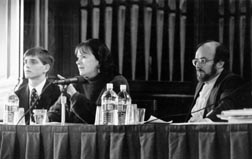 |
||||
| Student David Merrill left, with Schiller Institute Founder Helga Zepp LaRouche, and Mexican Tenor Alfredo Mendoza at Symposium. |
||||
Help Make A New Golden Renaissance!
Join the Schiller Institute and read
Fidelio Magazine Online.
A=432 herz C=256 herz C=512 herz |

